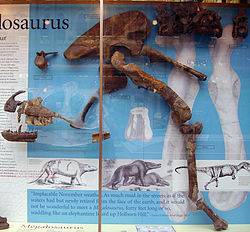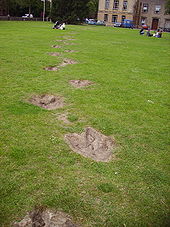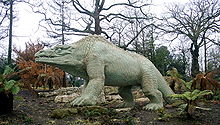- Megalosaurus
-
Megalosaurus
Temporal range: Middle Jurassic, 166 MaFossil specimens, Oxford University Museum of Natural History Scientific classification 
Kingdom: Animalia Phylum: Chordata Class: Reptilia Superorder: Dinosauria Order: Saurischia Suborder: Theropoda Family: †Megalosauridae Subfamily: †Megalosaurinae Genus: †Megalosaurus
Buckland, 1824Species: †M. bucklandii Binomial name Megalosaurus bucklandii
Mantell, 1827Megalosaurus (meaning "Great Lizard", from Greek, μεγαλο-/megalo- meaning 'big', 'tall' or 'great' and σαυρος/sauros meaning 'lizard') is a genus of large meat-eating theropod dinosaurs of the Middle Jurassic period (Bathonian stage, 166 million years ago) of Europe (Southern England, France, Portugal). It is significant as the first genus of dinosaur (outside of birds) to be described and named.
Contents
Discovery
"Scrotum humanum"
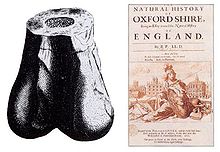 The cover of Robert Plot's Natural History of Oxfordshire, 1677 (right). Plot's illustration of the lower extremity of a Megalosaurus femur (left).
The cover of Robert Plot's Natural History of Oxfordshire, 1677 (right). Plot's illustration of the lower extremity of a Megalosaurus femur (left).
Megalosaurus may have been the first dinosaur to be described in the scientific literature. Part of a bone was recovered from a limestone quarry at Cornwell near Chipping Norton, Oxfordshire, England in 1676. The fragment was sent to Robert Plot, Professor of Chemistry at the University of Oxford and first curator of the Ashmolean Museum, who published a description in his Natural History of Oxfordshire in 1676. He correctly identified the bone as the lower extremity of the femur of a large animal and he recognized that it was too large to belong to any known species. He therefore concluded it to be the thigh bone of a giant human, such as those mentioned in the Bible. The bone has since been lost but the illustration is detailed enough that some have since identified it as that of Megalosaurus.[1]
The Cornwell bone was described again by Richard Brookes in 1763. He called it "Scrotum humanum," while comparing its appearance to a pair of human testicles. The label was not considered to be a proper Linnaean "name" for the animal in question at the time, and was not used in subsequent literature. Technically, though, the name was published after the advent of binomial nomenclature, and so if it was truly intended to represent the establishment of a new genus it would have priority over Megalosaurus.
However, the rules of the ICZN state that if a name has never been considered valid after 1899, it could be removed from competition for priority, becoming a nomen oblitum (forgotten name), while the junior synonym (in this case Megalosaurus bucklandi) could be made a nomen protectum (protected name).[2] In the early 1990s, W.A.S. Sarjeant submitted a petition to the ICZN to formally suppress the genus name Scrotum in favor of Megalosaurus. The Executive Secretary of the ICZN at the time, P.K. Tubbs, rejected the petition, concluding that the term "Scrotum humanum", published merely as a label for an illustration, did not constitute the valid creation of a new name, and stated that there was no evidence it was ever intended as such. Furthermore, the partial femur was too incomplete to definitely be referred to Megalosaurus and not a different, contemporary theropod.[3]
Buckland's research
More discoveries were made, starting in 1815, again at the Stonesfield quarry (currently considered part of the Taynton Limestone Formation, dating to the mid-Bathonian stage of the Jurassic Period).[4] They were acquired by William Buckland, Professor of Geology at the University of Oxford and dean of Christ Church. He did not know to what animal the bones belonged but, in 1818, after the Napoleonic Wars, the French comparative anatomist Georges Cuvier visited Buckland in Oxford and realised that the bones belonged to a giant lizard-like creature. Buckland then published descriptions of the bones in Transactions of the Geological Society, in 1824 (Physician James Parkinson had described them in an article in 1822).
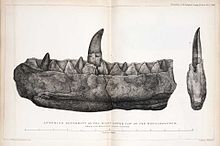 Engraving from William Buckland's "Notice on the Megalosaurus or great Fossil Lizard of Stonesfield", 1824. Caption reads "anterior extremity of the right lower jaw of the Megalosaurus from Stonesfield near Oxford".
Engraving from William Buckland's "Notice on the Megalosaurus or great Fossil Lizard of Stonesfield", 1824. Caption reads "anterior extremity of the right lower jaw of the Megalosaurus from Stonesfield near Oxford".
By 1824, Buckland had a piece of a lower jaw with teeth, some vertebrae, and fragments of pelvis, scapula and hind limbs, probably not all from the same individual. Buckland identified the organism as being a giant animal related to the Sauria (lizards) and he placed it in the new genus Megalosaurus, estimating the animal to be 12 m long in life.[5] In 1826, Ferdinand von Ritgen gave this dinosaur a complete binomial, Megalosaurus conybeari, which was not used by later authors and is now considered a nomen oblitum. A year later, in 1827, Gideon Mantell included Megalosaurus in his geological survey of southeastern England, and assigned the species its current binomial name, Megalosaurus bucklandii.[6] It would not be until 1842 that Richard Owen coined the term 'dinosaur'.
In 1997, a famous group of fossilised footprints (ichnites) was found in a limestone quarry at Ardley, 20 km Northeast of Oxford, England. They were thought to have been made by Megalosaurus and possibly also some left by Cetiosaurus. There are replicas of some of these footprints, set across the lawn of Oxford University Museum of Natural History.
Description
Since those first finds, many other Megalosaurus bones have been recovered but still no complete skeleton has been found. Therefore, the details of its physical appearance cannot be certain. However, a full description of all known material was recently published.[7]
Early reconstructions
In 1852, Benjamin Waterhouse Hawkins was commissioned to build a model of Megalosaurus for the exhibition of dinosaurs at the Crystal Palace in Sydenham, where it remains to this day. Early paleontologists, never having seen such a creature before, reconstructed it like the dragons of popular mythology, with a huge head and walking on all fours. The hump on the back of the sculpture in Crystal Palace and other restorations from the 1800s was based on the material now referred to as Becklespinax.[8] It was not until the middle of the nineteenth century, when other theropods began to be discovered in North America, that a more accurate picture was developed. Some confusion still exists, for at one time, all theropods from Europe were given the title Megalosaurus.[citation needed] Since then, these have mostly been reclassified. For further confusion, the most reproduced anatomy diagram of a Megalosaurus' skeleton was produced before any vertebrae had been recovered. While drawing it, Friedrich von Huene of the University of Tübingen, Germany, instead used the backbones of Altispinax, a mysterious big theropod known from high-spined dorsal vertebrae and at times classified as a spinosaur.[citation needed] Hence, many later drawings, based on his original, show Megalosaurus with a deep spinal ridge or even a small sail, like that of Spinosaurus.[citation needed]
Modern reconstructions
Megalosaurus had a relatively large head and its teeth were those of a carnivore.[citation needed] However, the long tail would have balanced the body and head and so Megalosaurus is now restored as bipedal—like all other theropods—about 9 meters in length.[citation needed] The structure of the cervical vertebrae suggests that its neck would have been very flexible.[citation needed] To support its weight of around one tonne, the legs were large and muscular.[citation needed] Like most theropods, it had three forward-facing toes and a hallux.[citation needed] Its forelimbs were small - although not proportionally as small as those of later theropods like Tyrannosaurus - and probably had three or four digits.[citation needed]
Living in what is now Europe, during the Jurassic Period (181 to 169 million years ago), Megalosaurus may have hunted stegosaurs and sauropods.[citation needed] Repeated descriptions of Megalosaurus hunting Iguanodon (another of the earliest dinosaurs named) through the forests that then covered the continent are probably inaccurate, because Iguanodon skeletons are found in much younger Early Cretaceous formations. No fossils assignable to Megalosaurus have been discovered in Africa, contrary to some outdated dinosaur books.[citation needed]
The Oxford University Museum of Natural History contains a descriptive display of Megalosaurus and of the history of its discovery.[citation needed]
Classification
At one time, Megalosaurus was a 'wastebasket genus', and included many diverse species of large theropods. Carcharodontosaurus,[9] Dilophosaurus,[10] Eustreptospondylus,[11] Metriacanthosaurus,[12] and Duriavenator, were all initially classified as species of Megalosaurus. During the 20th Century, the genus was subject to extensive reclassification and most of these species were given their own genera.
Paleobiology
Paleopathology
A Megalosaurus rib figured in 1856 and 1884 by Sir Richard Owen has a pathological swollen spot near the base of its capitular process.[13] In a 2001 study conducted by Bruce Rothschild and other paleontologists, 16 foot bones referred to Dilophosaurus were examined for signs of stress fracture, but none were found.[14]
In popular media
Megalosaurus has the distinction of being the first dinosaur to appear in any popular media. Charles Dickens' novel Bleak House begins with a description of muddy streets, whose primordial character is emphasized by mention of Megalosaurus: Implacable November weather. As much mud in the streets as if the waters had but newly retired from the face of the earth, and it would not be wonderful to meet a Megalosaurus, forty feet long or so, waddling like an elephantine lizard up Holborn Hill.
It has made a variety of other appearances as well. A Megalosaurus was one of the main dinosaurs featured in John Brosnan's 1984 novel, Carnosaur, though it was not featured in its film adaptation. In the TV show Dinosaurs, Earl Sinclair, the father, is a Megalosaurus. It also appears in the Doctor Who book The Last Dodo by Jacqueline Rayner.
References
- ^ Sarjeant, William A.S. (1997). "The earliest discoveries". In Farlow, James O.; and Brett-Surman, Michael K. (eds.). The Complete Dinosaur. Bloomington: Indiana University Press. pp. 3–11. ISBN 0-253-33349-0.
- ^ Halstead, L.B. (1970). "Scrotum humanum Brookes 1763 - the first named dinosaur." Journal of Insignificant Research, 5: 14–15.
- ^ Halstead, L.B. and Sarjeant, W.A.S. (1993). "Scrotum humanum Brookes - the earliest name for a dinosaur?" Modern Geology, 18: 221-224.
- ^ Benson, R.B.J. (2009). "An assessment of variability in theropod dinosaur remains from the Bathonian (Middle Jurassic) of Stonesfield and New Park Quarry, UK and taxonomic implications for Megalosaurus bucklandii and Iliosuchus incognitus". Palaeontology 52 (4): 857–877. doi:10.1111/j.1475-4983.2009.00884.x.
- ^ Buckland, W. (1824). "Notice on the Megalosaurus or great Fossil Lizard of Stonesfield." Transactions of the Geological Society of London, series 2, vol. 1: 390–396.
- ^ Mantell, G. (1827). "Illustrations of the geology of Sussex: a general view of the geological relations of the southeastern part of England, with figures and descriptions of the fossils of Tilgate Forest."
- ^ Benson, R.B.J. (2010). "A description of Megalosaurus bucklandii (Dinosauria: Theropoda) from the Bathonian of the UK and the relationships of Middle Jurassic theropods". Zoological Journal of the Linnean Society 158: 882. doi:10.1111/j.1096-3642.2009.00569.x.
- ^ http://dml.cmnh.org/1997Feb/msg00333.html
- ^ Deparet, C. and Savornin, J. (1927). "Sur la decouverte d'une faune de vertebres albiens a Timimoun (Sahara occidental)." Comptes Rendus, Academie du Sciences, Paris, 181: 1108-1111.
- ^ http://www.ucmp.berkeley.edu/dilophosaur/details.html
- ^ http://www.thescelosaurus.com/tetanurae.htm
- ^ http://www.enchantedlearning.com/subjects/dinosaurs/facts/Metriacanthosaurus/
- ^ Molnar, R. E., 2001, Theropod paleopathology: a literature survey: In: Mesozoic Vertebrate Life, edited by Tanke, D. H., and Carpenter, K., Indiana University Press, p. 337-363.
- ^ Rothschild, B., Tanke, D. H., and Ford, T. L., 2001, Theropod stress fractures and tendon avulsions as a clue to activity: In: Mesozoic Vertebrate Life, edited by Tanke, D. H., and Carpenter, K., Indiana University Press, p. 331-336.
Categories:- Jurassic dinosaurs
- Dinosaurs of Europe
- Megalosaurs
Wikimedia Foundation. 2010.

